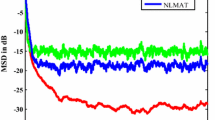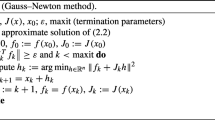Abstract
This paper proposes a simplified neural network for generalized least absolute deviation by transforming its optimization conditions into a system of double projection equations. The proposed network is proved to be stable in the sense of Lyapunov and converges to an exact optimization solution of the original problem for any starting point. Compared with the existing neural networks for generalized least absolute deviation, the new model has the least neurons and low complexity and is suitable to parallel implementation. The validity and transient behavior of the proposed neural network are demonstrated by numerical examples.





Similar content being viewed by others
References
Xia Y, Kamel M (2008) A generalized least absolute deviation method for parameter estimation of autoregressive signals. IEEE Trans Neural Netw 19(1):107–118
Bloomfield P, Steiger W (1983) Least absolute deviations: theory applications and algorithms. Brikhäuser, Boston
Shi M, Lukas M (2002) An L 1 estimation algorithm with degeneracy and linear constraints. Comput Stat Data Anal 39(1):35–55
Liu X, Gao X et al (2012) Image restoration method based on l 1-nonconvex nonsmooth function. Comput Eng 38:190–193
Bazaraa M, Sherali H, Shetty C (1993) Nonlinear programming: theory and algorithms, 2nd edn. Wiley, New York
Xia Y, Kamel M (2007) Cooperative recurrent neural networks for the constrained L 1 estimator. IEEE Trans Signal Process 55(7):3192–3206
Wang Z, Peterson B (2008) Constrained least absolute deviation neural networks. IEEE Trans Neural Netw 19(2):273–283
Xia Y (2009) A compact cooperative recurrent neural network for computing general constrained L 1 norm estimators. IEEE Trans Signal Process 57(9):3693–3697
Wang Z, He Z, Chen J (2005) Robust time delay estimation of bioelectric signals. IEEE Trans Bio med Eng 52(3):454–462
Hu X, Sun C, Zhang B (2010) Design of recurrent neural networks for solving constrained least absolute deviation problems. IEEE Trans Neural Netw 21(7):1073–1086
Xia Y (2010) A fast algorithm for constrained GLAD estimation with application to image restoration. In: Proceedings of the 8th world congress on intelligent control and automation, Jinan, China, July
Hopield J, Tank D (1986) Computing with neural circuits: a model. Science 233(4764):625–633
Tank D, Hopfield J (1986) Simple neural optimization networks: an a/d converter, signal decision circuit, and a linear programming circuit. IEEE Trans Circuits Syst 33:533–541
Kennedy M, Chua L (1988) Neural networks for nonlinear programming. IEEE Trans Circuits Syst 35:554–562
Zhang S, Constantinides A (1992) Langrange programming neural networks. IEEE Trans Circuits Syst 39(7):441–452
Xue X, Bian W (2008) Subgradient-based neural networks for nonsmooth convex optimization problems. IEEE Trans Circuits Syst I Regul Pap 55(8):2378–2391
Qin S, Xue X (2015) A two-layer recurrent neural network for nonsmooth convex optimization problems. IEEE Trans Neural Netw Learn Syst 26(6):1149–1160
Bian W, Xue X (2013) Neural network for solving constrained convex optimization problems with global attractivity. IEEE Trans Circuits Syst I Regul Pap 60(3):710–723
Qin S et al (2015) Neural network for constrained nonsmooth optimization using Tikhonov regularization. Neural Netw 63:272–281
Liu X, Zhou M (2016) A one-layer recurrent neural network for non-smooth convex optimization subject to linear inequality constraints. Chaos Solitons Fractals 87:39–46
Wang Z, Cheung J et al (2000) Neural implementation of unconstrained minimum L 1-norm optimization least absolute deviation model and its application to time delay estimation. IEEE Trans Circuits Syst II Analog Digital Sig Process 47(11):1214–1226
Xia Y, Kamel M (2008) A cooperative recurrent neural network for solving L 1 estimation problems with general linear constraints. Neural Comput 20(3):844–872
Liu Q, Zhao Y, Cheng L (2015) Continuous-time multi-agent network for distributed least absolute deviation. In: International Symposium on Neural Networks. Springer International Publishing, pp 436–443
Liu Q, Wang J (2015) A second-order multi-agent network for bound-constrained distributed optimization. IEEE Trans Autom Control 60(12):3310–3315
Liu Q, Wang J (2016) L 1-minimization algorithms for sparse signal reconstruction based on a projection neural network. IEEE Trans Neural Netw Learn Syst 27(3):698–707
Li C, Gao X, Li Y, Liu R (2016) A new neural network for l 1-norm programming. Neurocomputing 202:98–103
Xia Y, Kamel M (2007) Novel cooperative neural fusion algorithms for image restoration and image fusion. IEEE Trans Image Process 16(2):367–381
Xia Y, Sun C, Zheng W (2012) Discrete-time neural network for fast solving large linear L 1 estimation problems and its application to image restoration. IEEE Trans Neural Netw Learn Syst 23(5):812–820
Gao X (2001) A neural network for a class of extended linear variational inequalities. Chin J Electron 10(4):471–475
Gao X (2004) A novel neural network for nonlinear convex programming. IEEE Trans Neural Netw 15(3):613–621
Gao X, Du L (2006) A neural network with finite-time convergence for a class of variational inequalities. Lect Notes Comput Sci 4113:32–41
Gao X, Liao L (2003) A neural network for monotone variational inequalities with linear constraints. Phys Lett A 307(2–3):118–128
Gao X, Liao L (2006) A novel neural network for a class of convex quadratic minimax problems. Neural Comput 18(8):1818–1846
Gao X, Liao L (2009) A new projection-based neural network for constrained variational inequalities. IEEE Trans Neural Netw 15(4):622–628
Gao X, Liao L (2010) A new one-layer network for linear and quadratic programming. IEEE Trans Neural Netw 21(6):918–929
He X, Huang T et al (2017) An inertial projection neural network for solving variational inequalities. IEEE Trans Cybern 47(3):809–814
Liu Q, Wang J (2015) A projection neural network for constrained quadratic minimax optimization. IEEE Trans Neural Netw Learn Syst 26(11):2891–2900
Friesz T, Bernstein D et al (1994) Day-to-day dynamic network disequilibria and idealized traveler information systems. Oper Res 42:1120–1136
Xia Y, Wang J (1998) Neural networks for solving least absolute and related problems. Neurocomputing 19:13–21
Wang Z, Cheung J, Xia Y (2000) Minimum fuel neural networks and their applications to overcomplete signal respresentations. IEEE Trans Circuit Syst I Fundam Theory Appl 47(8):1146–1159
Li G, Yan Z, Wang J (2015) A one-layer recurrent neural network for constrained nonconvex optimization. Neural Netw 61:10–21
Li G, Yan Z, Wang J (2014) A one-layer recurrent neural network for constrained nonsmooth invex optimization. Neural Netw 50:79–89
Liu Q, Dang C, Huang T (2013) A one-layer recurrent neural network for real-time portfolio optimization with probability criterion. IEEE Trans Cybern 43(1):12–23
Li S, Li Y, Wang Z (2013) A class of finite-time dual neural networks for solving quadratic programming problems and its k-winners-take-all application. Neural Netw Off J Int Neural Netw Soc 39(1):27–39
Li S, Chen S, Liu B (2013) Accelerating a recurrent neural network to finite-time convergence for solving time-varying sylvester equation by using a sign-bi-power activation function. Neural Process Lett 37(2):189–205
Li S, Li Y (2014) Nonlinearly activated neural network for solving time-varying complex sylvester equation. IEEE Trans Cybern 44(8):1397–1407
Li S, He J et al (2017) Distributed recurrent neural networks for cooperative control of manipulators: a game-theoretic perspective. IEEE Trans Neural Netw Learn Syst 28(2):415–426
Li S, Zhang Y, Jin L (2016) Kinematic control of redundant manipulators using neural networks. IEEE Trans Neural Netw Learn Syst. doi:10.1109/TNNLS.2016.2574363
Liu S, Wang J (2006) A simplified dual neural network for quadratic programming with its kwta application. IEEE Trans Neural Netw 17(6):1500–1510
Kinderlehrer D, Stampcchia G (1980) An introduction to variational inequalities and their applications. Academic, New York
La Salle J (1976) The stability of dynamical systems. SIAM, Philadelphia
Acknowledgements
The authors would like to thank the Editor-in-Chief and three anonymous reviewers for their insightful and constructive comments, which have enriched the content and improved the presentation of this paper. This work was supported in part by the National Natural Science Foundation of China under Grant 61273311, and the Fundamental Research Funds for the Central Universities under Grant GK201603002.
Author information
Authors and Affiliations
Corresponding author
Ethics declarations
Conflict of interest
The authors declare that there is no conflict of interests (either financial or nonfinancial) regarding the publication of the paper.
Rights and permissions
About this article
Cite this article
Li, Y., Gao, X. Simplified neural network for generalized least absolute deviation. Neural Comput & Applic 29, 1455–1463 (2018). https://doi.org/10.1007/s00521-017-3060-2
Received:
Accepted:
Published:
Issue Date:
DOI: https://doi.org/10.1007/s00521-017-3060-2




